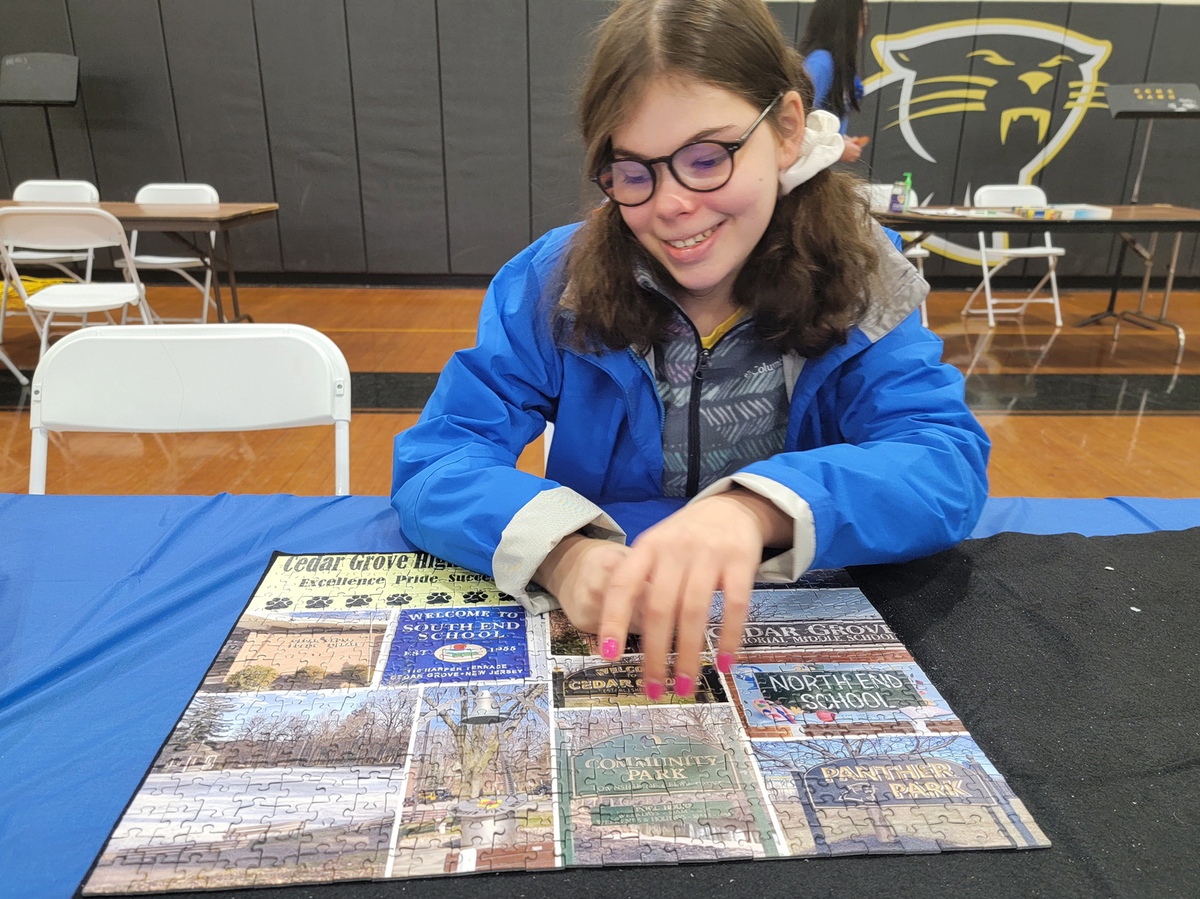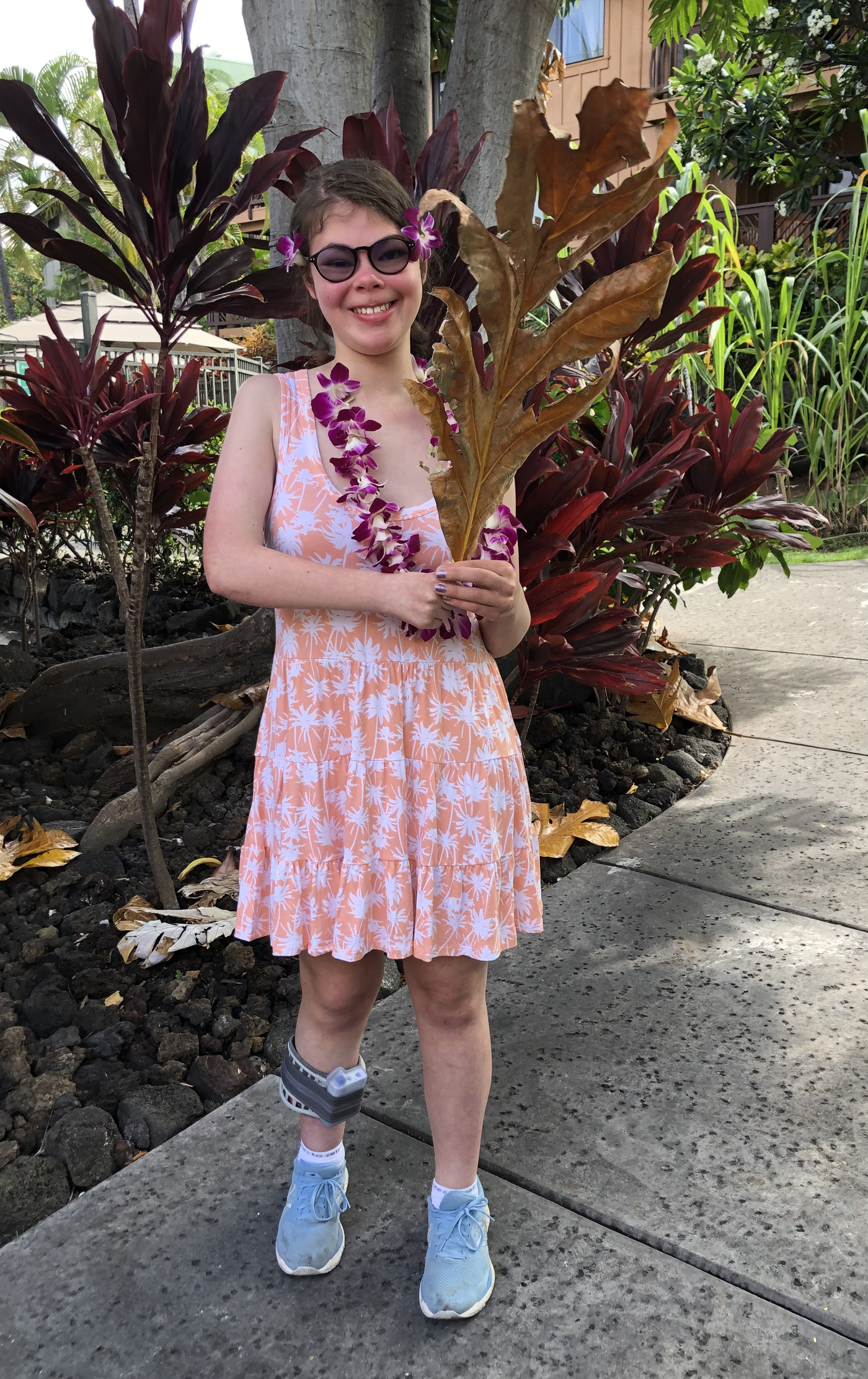[ad_1]
Mora Leeb locations some items right into a puzzle throughout a neighborhood puzzle event. The 15-year-old has grown up with out the left facet of her mind after it was eliminated when she was very younger.
Seth Leeb
conceal caption
toggle caption
Seth Leeb

Mora Leeb locations some items right into a puzzle throughout a neighborhood puzzle event. The 15-year-old has grown up with out the left facet of her mind after it was eliminated when she was very younger.
Seth Leeb
In most individuals, speech and language reside within the mind’s left hemisphere. Mora Leeb just isn’t most individuals.
When she was 9 months outdated, surgeons eliminated the left facet of her mind. But at 15, Mora performs soccer, tells jokes, will get her nails achieved, and, in some ways, lives the lifetime of a typical teenager.
“I may be described as a glass-half-full woman,” she says, announcing every phrase rigorously and with out inflection. Her sluggish, cadence-free speech is one signal of a mind that has needed to reorganize its language circuits.
But to a outstanding diploma, Mora’s proper hemisphere has taken on jobs often achieved on the left facet. It is an excessive model of mind plasticity, the method that enables a mind to switch its connections to adapt to new circumstances.
Mind plasticity is believed to underlie studying, reminiscence, and early childhood growth. It is also how the mind revises its circuitry to assist get better from a mind harm — or, in Mora’s case, the lack of a whole hemisphere.
Scientists hope that by understanding the brains of individuals like Mora, they will discover methods to assist others get better from a stroke or traumatic mind harm. Additionally they hope to realize a greater understanding of why very younger brains are so plastic.
An harm earlier than delivery
Someday within the third trimester of Ann Leeb’s being pregnant, the kid she was carrying had an enormous stroke on the left facet of her mind. Nobody knew it on the time.
Mora was born in September of 2007. And for the primary few months, she appeared like a typical child. She smiled and rolled over, proper on schedule.
“After which within the vacation season of 2007, all of those milestones type of stopped,” Leeb recollects.
In early 2008, Mora started having epileptic seizures that grew to become increasingly more frequent. “There have been 20 of them in a minute after which there have been a whole bunch of them a day,” Leeb says.
Medical doctors ordered an MRI of Mora’s mind. They confirmed the picture to Ann and her husband, Seth.
“Seth and I’ve no background in drugs,” Leeb says. “However you simply did not want it to learn that MRI. Half of her mind was lit up and the opposite half of her mind was principally grey.”
Many of the cells in her left hemisphere had died. Those that remained have been inflicting her unrelenting seizures. So the Leebs traveled from their residence in South Orange, New Jersey, to the Cleveland Clinic, the place Dr. William Bingaman carried out a hemispherectomy, which removes many of the tissue on one facet of the mind.
“Principally the surgical procedure created a new child,” Leeb says. “She might not roll over. She might not smile. It was nearly like a restart.”
The group of a typical human mind is contralateral, that means the left facet of the mind is related to the motor and sensory nerves controlling the correct facet of the physique. So Mora was initially paralyzed on her proper facet.
Human brains are additionally lateralized, which permits every hemisphere to concentrate on processing sure kinds of info, or particular behaviors. Mora had misplaced the left-brain areas that often play a vital position in producing and understanding speech. That meant her proper mind must tackle these jobs if she was ever going to hold on a dialog or learn a ebook.
The higher bounds of mind plasticity
Ann and Seth Leeb knew that younger kids who endure hemispherectomy can typically thrive with simply half a mind. In order that they devoted themselves to offering their daughter with the absolute best rehabilitation providers obtainable.
Mora noticed a physiatrist and a speech language pathologist. She received bodily remedy, occupational remedy, and plenty of encouragement from her mother and father.
And regularly, Mora started to enhance.

Mora holds a palm frond after stringing her personal lei whereas on a household trip.
Seth Leeb
conceal caption
toggle caption
Seth Leeb

Mora holds a palm frond after stringing her personal lei whereas on a household trip.
Seth Leeb
“At 18 months, she lastly sat up,” Leeb says. “And at 23 months she lastly walked.”
Mora was 6 and a half when she started utilizing sentences. By the point she had her bat mitzvah, she was capable of give a brief speech about dwelling with half a mind.
Individuals like Mora symbolize the higher bounds of human mind plasticity as a result of their brains have been radically altered very early in life — a interval when the wiring continues to be a piece in progress.
For instance, in an grownup mind, phrases are usually processed on the left facet, whereas faces are processed on the correct.
However “your mind does not begin out having phrase recognition fully on the left and face recognition fully on the correct,” says Michael Granovetter, a researcher on the College of Pittsburgh.
Early on, these two vital features seem to compete for area, he says. To provide every sufficient room, the mind often pushes phrases to the left and faces to the correct.
Realizing that left Granovetter and different researchers pondering a query:
“If this competitors between phrase recognition and face recognition within the mind performs out over growth, what if just one hemisphere was obtainable, what may we see?” Granovetter says. “Can one hemisphere tackle the burden of two?”
The existence of individuals like Mora urged that it might. However scientists hadn’t achieved a lot to research the phenomenon.
A research of half-brain skills
So Granovetter and a group of scientists got down to research face and phrase recognition in 40 individuals, ages 6 to 38, who’d misplaced half their mind early in life. Mora was considered one of them.
Ann and Seth Leeb heard concerning the research by the Pediatric Epilepsy Surgery Alliance, a gaggle shaped by a pair whose son had a hemispherectomy. The Leebs inspired their daughter to take part, partly to assist different individuals with mind accidents, but in addition to study extra about Mora’s mind.
“We have been very excited, really, to see, maybe, the place within the mind issues have migrated,” Leeb says.
The researchers knew that when adults expertise an harm to at least one facet of the mind, it typically ends in everlasting impairment. A stroke on the correct facet tends to impair facial recognition, whereas a stroke on the left facet tends to have an effect on an individual’s speech and language.
So the group anticipated to seek out big deficits in individuals who’d misplaced a whole hemisphere.
“A lot to our shock, we discovered that that is completely not true,” says Marlene Behrmann of Carnegie Mellon College. “Regardless of whether or not the left or the correct hemisphere is preserved, these youngsters can acknowledge each faces and phrases.”
However not in addition to comparable aged individuals with two intact hemispheres. The individuals within the research recognized each phrases and faces with about 80% accuracy. A management group averaged 90% or extra.
The outcome means that the remaining hemispheres rewired to protect each features, moderately than favoring the perform often discovered on that facet. It additionally exhibits that half a mind cannot totally replicate the capabilities of a full one.
Mora, for instance, has some limitations, says Dr. Lisa Shulman, a neurodevelopmental pediatrician on the Youngsters’s Hospital at Montefiore in New York.
“She speaks and processes [words] very slowly,” Shulman says, “And she or he has an nearly telegraphic high quality to her speech: one – phrase – at – a – time.”
That is widespread amongst individuals of all ages who’ve an harm to the left facet of the mind, Shulman says. “Once you lose that left facet, which is controlling a variety of motor functioning, it may well influence the mouth, the tongue, the palate — how all these issues come into play.”
Mora additionally stays weak on the correct facet of her physique, and typically struggles to detect nuance in language.
A mixture of strengths and weaknesses
Throughout an interview with Mora, each her skills and deficits have been obvious. So was her outgoing persona and curiosity concerning the world.
Mora started by telling me a joke: “How do you make a scorching canine stand?” she asks. “You’re taking away its chair.”
It is a easy punchline, delivered with a pun a second-grader would in all probability get. However utilizing puns in any respect requires a reasonably subtle understanding of language.
Later, after I ask Mora about her bat mitzvah speech, she talks about describing her lifestyle by idioms like “glass half full” and “rose-colored glasses.”
Each examples present how Mora, at 15, is continuous to go developmental and linguistic milestones, regardless of a sluggish begin.
However in the course of the interview, Mora typically wanted prompts from her mom to grasp questions. And her speech, at instances, was halting and vague.
Her final query, although, was loud and clear: After I clarify that her story shall be on the radio, she asks, “When?”
The way forward for a half-full woman
Mora Leeb, who did not use sentences till she was 6 and a half, now loves to look at sport exhibits involving phrases and phrases.
“Don’t name our home between seven and eight within the night as a result of we’re devoted Jeopardy and Wheel of Fortune followers,” Ann Leeb says.
Mora additionally has exceeded the hopes of the medical doctors and therapists who’ve labored together with her through the years.
“Each time I see her, she’s achieved one thing I couldn’t have imagined after I first met her,” Shulman says.
A type of issues, Shulman says, is to develop a full-fledged persona — a lady who likes to play ping pong, to have her hair put in French braids, and who often talks again to her mother.
“I’ve challenges of being the mom of a youngster,” Leeb says. “Within the morning, she does not need to get off the bed. Within the night, she does not need to go to mattress.”
What scientists nonetheless need to know is exactly what allowed Mora’s mind to rewire so extensively. Was it her age? The years of intensive remedy? An undiscovered organic issue?
One factor is evident: Understanding the idea of this type of excessive plasticity, they are saying, might assist tens of millions of individuals whose brains are nonetheless attempting to get better from a stroke, tumor, or traumatic harm. And Mora helps scientists deepen their understanding, just by being herself.
[ad_2]
Source link
















